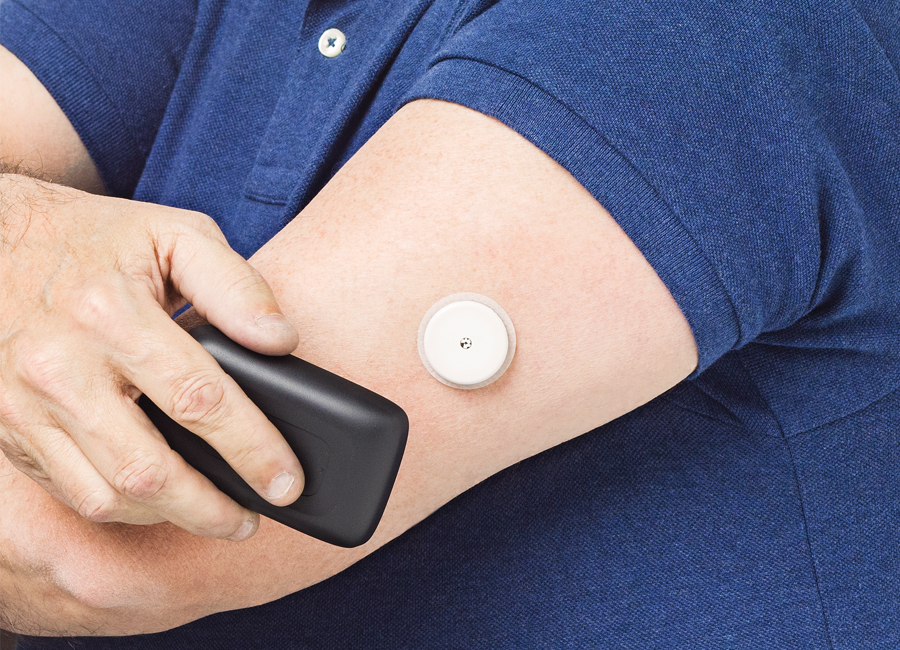New Tech Changing the Lives of Seniors Living with Diabetes

SPONSORED CONTENT
Technological advancements in the management of diabetes is changing at an exponential rate1, which is great news for the up to 45 percent of Canadian seniors affected by diabetes2. A key goal for people to manage their diabetes can potentially be achieved with new technology to comfortably and continuously view and manage glucose levels.
A Technology that Empowers
Self-monitoring has always been considered an integral component of proper diabetes management. For the past few decades3, blood glucose test strips have been the most common method of glucose monitoring, yet many struggle to meet the recommended target of testing more than three times a day4.
A 2018 CARP member survey5 revealed that the majority of respondents (65%) who are living with diabetes or caring for someone with diabetes check their glucose levels as little as one to three times a day. The survey showed the unaffordability of test strips and the pain of testing as two of the major barriers to regular glucose monitoring.
Thankfully, new technology may help to manage and monitor glucose levels, without a painful routine* finger prick. Flash glucose monitoring is a new innovation for those living with diabetes.

Did you know?
The 2018 Diabetes Canada Clinical Practice Guidelines6, released in April of this year, added an innovative new category in self-monitoring for people with type 1 and type 2 diabetes. Flash glucose monitoring automatically measures, captures and stores glucose level data continuously so that patients and their doctors can see patterns over time and make adjustments to lifestyle, diet or treatment, when needed… and reduces the need for routine finger pricks.7
A New Method of Self-Managing
Those who are able to afford the new flash glucose monitoring FreeStyle Libre system understand its impact. At 61-years old, Danny was diagnosed with diabetes just six years ago. Once diagnosed, he never went on insulin. He is taking pills to manage his disease.
“I’ve been pricking my fingers for six years,” Danny explains—so when FreeStyle Libre system became an option, Danny’s endocrinologist told him to “go for it”.
The FreeStyle Libre system offers him a full eight hours’ worth of data on his glucose levels—a constant aid for managing his diabetes.
“I don’t have to poke myself and I can monitor myself as many times a day as I want,” says Danny, “I can tell you exactly when I’m good and when I’m not good.”
Danny’s FreeStyle Libre system isn’t covered by insurance. Instead he covers the costs himself. It’s a tough pill to swallow. But, diabetes is costly—and Danny is willing to make the investment.
“This is my health,” he says.
The 2018 CARP member survey revealed that 94% of Canadian seniors living with diabetes or caring for someone with diabetes believe the government should ensure that people living with diabetes do not have to pay out-of-pocket for an innovative flash glucose monitoring system.
For the near future, it comes down to the accessibility of the new technology. For many Canadians, this innovative technology for people with diabetes may remain unattainable8 until it is covered under provincial healthcare plans. If you believe it should be covered, talk to your MPP.
The FreeStyle Libre flash glucose monitoring system is indicated for measuring interstitial fluid glucose levels in adults aged 18 years and older who have at least 2 years of experience in self-managing their diabetes. For In Vitro Diagnostic Use Only. Always read and follow the label/insert for detailed instructions and indication of use.
This article was paid for by Abbott Diabetes Care, a manufacturer of diabetes care products in Canada. This is an actual testimonial of a FreeStyle Libre system user and Abbott has consent to use their story. Consent is on file with Abbott.
* A finger prick test using a blood glucose meter is required during times of rapidly changing glucose levels when interstitial fluid glucose levels may not accurately reflect blood glucose levels or if hypoglycemia or impending hypoglycemia is reported by the system or when symptoms do not match the system readings.
1 Canadian Journal of Diabetes. (June, 2015). Diabetes Technology and Devices Transform the Lives of People with Diabetes. Retrieved from: https://www.canadianjournalofdiabetes.com/article/S1499-2671(15)00393-7/fulltext. Accessed May 2018.
2 Public Health Agency of Canada. (March 3, 2014). Your Guide to Diabetes. Retrieved from: https://www.canada.ca/en/public-health/services/chronic-diseases/reports-publications/diabetes/your-guide-diabetes.html. Acessed May 2018.
3 Diabetes Canada. History of Diabetes. Retrieved From: http://www.diabetes.ca/about-diabetes/history-of-diabetes. Accessed May 2018.
4 Berard LD, et al. 2018 Clinical Practice Guidelines. Monitoring Glycemic Control. Can J Diabetes 2018;42:S47–S53.
5 Canadian Association of Retired Persons. CARP Diabetes Member Survey. May 2018. Survey results on file.
6 Diabetes Canada Clinical Practice Guidelines Expert Committee. Monitoring Glycemic Control. 2018. Can. J. Diabetes. 42: S47-S53. Accessed May 2018.
7 Canada News Wire. (May 3, 2018).Revolutionary New Category of Diabetes Self-Monitoring Systems Recognized in 2018 Diabetes Canada Clinical Practice Guidelines. Retrieved from: https://www.newswire.ca/news-releases/revolutionary-new-category-of-diabetes-self-monitoring-systems-recognized-in-2018-diabetes-canada-clinical-practice-guidelines-681650411.html. Accessed May 2018.
8 Canadian Association of Retired Persons. CARP Diabetes Member Survey. May 2018. Survey results on file.
ADC-08276